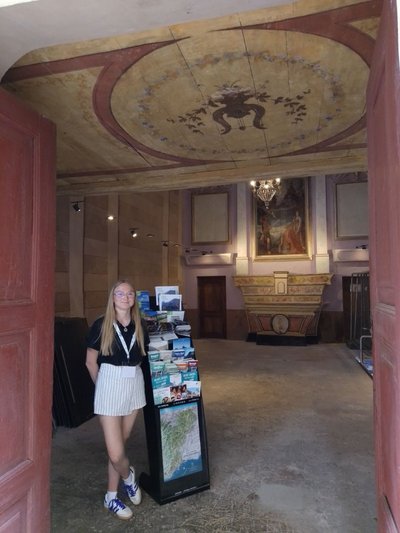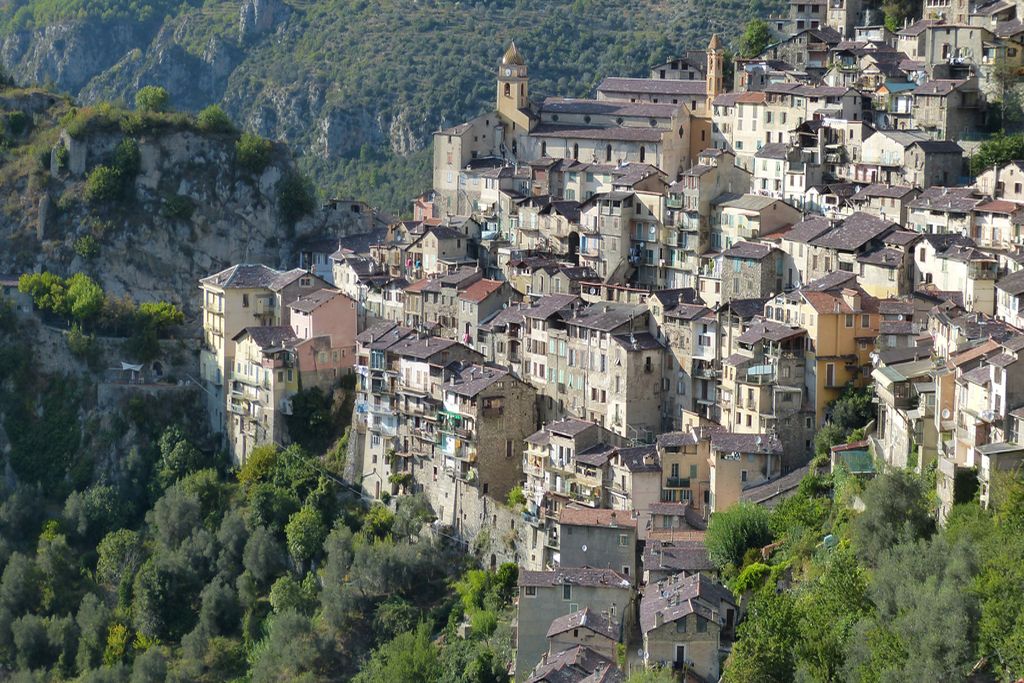
Saorge
8 points of interest
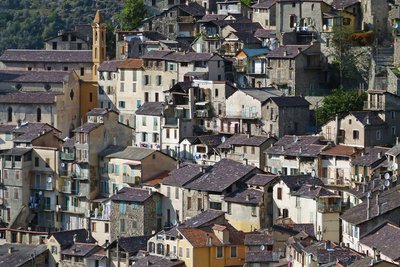
Le village de Saorge - Laurent MALTHIEUX  History and historical trail
History and historical trailSaorge, a monumental village
Stronghold of the Falerna tribe during Roman times, Saorge had a number of masters: Anjou, Savoie, France….
A fortified place in the gorges which locked in the important commercial and strategic street of La Roya, it was reinforced by the castles, which are today in ruins, of Malamort and Salines.
After the destruction of Saint-Georges castle, a garrison containing 400 men, by Général Masséna at the head of the Armies of the Republic in April 1794, Saorge still looks harmonious today with its tall houses spread over a giddying amphitheatre overlooking the tempestuous course of the Roya. Narrow, winding and sometimes dark alleys circulate in this extremely tight building.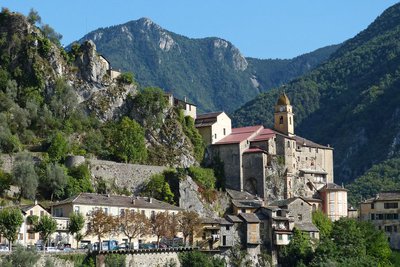
Eglise de Saorge côté ouest - Laurent MALTHIEUX  History and historical trail
History and historical trailChurch of Saint-Sauveur
The church of Saint-Sauveur is a classified historical monument and on its arch can be seen the coat of arms of Saorge: Saint George slaying the dragon. In a 15th-century style, the church is richly furnished, including a fine Virgin with Child.
Its tremendous 1840 Italian organ were made by the master organ-maker Lingiardi: their exceptional sound allows a repertoire inspired by Rossini’s operas to be played.
The square bell tower, with a a small dome, contains 4 bells which were made in Nice in 1834; they ring out joyously during religious festivals, calling the inhabitants of this still very lively village to come along.
 History and historical trail
History and historical trailThe chapels of the Penitents
Bearing witness to the strong religious feelings which were present in the community of Saorge, three chapels of the Penitents, today classified as historical monuments, were built at the start of the 17th century.
The confraternities of the Penitents were spread throughout Occitania from the 13th century onwards, made up of men and women “of good life and morals”, with the “reputation of being genuinely religious”.
The chapel of the Red Penitents, devoted to Saint Sébastien, was abandoned in 1950 and turned into a warehouse and electrical transformer.
The chapel of the white penitents has Saint James the Great as its patron; it pretty bell tower with varnished tiles gleams in the sunlight and contrasts with the building’s state of disrepair.
A Saorge, toitures en lauzes et clocher. - GRANDJEAN Denis  History and historical trail
History and historical trailChapelle des Pénitents Noirs
Under the patronage of Saint Claude, the chapel is built into the frame of the houses: the gentle ochre of its wall catches the eye. The confraternity of Mercy brought together nobles to provide help for the needy. Restored and turned into a museum, it reopened its doors again in summer 1989.
Opposite the chapel, the charming Bellevue hotel’s restaurant room provides a delightful view over the Roya valley.
Façade du monastère de Saorge. Chaleur d'un éclairage d'automne. - Eric LE BOUTEILLER  History and historical trail
History and historical trailThe Franciscan convent
Originally, where the convent is now, there stood an oratory devoted to Saint Bernard of Menthon. After many difficulties, the bishop of Vintimille granted the right to build a Franciscan convent on 19th January 1639.
A classified historical monument, this 17th-century convent includes a baroque church with a pink facade and an onion dome; a covered two-level cloister with beautiful woodwork.
The forty cells in the white building are today filled with the silence of absence.
The last monks, who ran the Sunday service and the Nativity mass, have left. Only a guardian remains, providing guided visits to at the weekend to those who are interested by this building, over which cypress trees stand guard.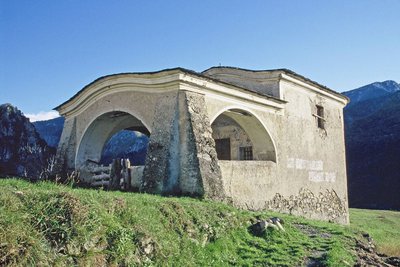
La chapelle Sainte-Croix à Saorge, sur le chemin de la Baisse d'Anan. - Roger SETTIMO  History and historical trail
History and historical trailChapelle Sainte-Croix
Half way up the rounded ridge of a slope which has been moulded by the man-made terraces, the huge and elegant outline of Chapelle Sainte-Croix towers above. Abandoned, it used to store the hay harvested in the surrounding area: large bales of it can be seen scattered across the fields which are made rich by the presence of springs.
At the beginning of the 19th century, the fertile ground sustained a herd of 6000 goats and 12000 sheep. Today, the “neo-rural” generation seems to be replacing the locals who, due to wars and the attractions of the cities, are less numerous.
 History and historical trail
History and historical trailChapelle Sainte-Anne
Nestled among some trees along a promontory, chapelle Sainte-Anne ovrlooks the wild valley of Bendola; every year, a pilgrimage brings several worshippers to the area, as a procession from Saorge to the smalle sanctuary.
Le clocher imposant et la chapelle romane, "la Madone Del Poggio" à Saorge. - Jacques SARRUT  History and historical trail
History and historical trailOur Lady, pray for the salvation of our souls!
On 4th January 1092, the newly built chapel of Sainte-Marie, was given to the monastery of Lérins, as well as land including houses, mills, vines and meadows.
Four priests and two members of the secular clergy would reside in the house adjoining the chapel and they would sing every day for the salvation of those who signed the gift charter.
A long-term lease was signed on 10th September 1668, between the Lérins monastery and the nobleman J.F. Davéo. After the Revolution in 1789, Notre Dame du Puy became part of the family’s estate, which today has no heir, and took the name Notre-Dame del Poggio.
Description
As you enter the village, head up the climb on the left, going past the church of Saint-Sauveur. From the forecourt, an alley with steps rises all the way to the Chapelle des Pénitents Blancs.
Subsequently, join the main street which goes past the Chapelle des Pénitents Noirs. At the foot of the rural staircase which leads to the Couvent des Franciscains, note the attractive pountin, a little stone bridge between a house and a street, above another street.
After visiting the convent, which today no longer hosts its worshippers, take the cobbled path which is bordered by small walls and which winds up the sunny slopes overlooking the Bendola Valley. It goes past the lodge, heading into the countryside. A sheltered fountain is a source of crystal clear water and then an attractive stone bridge shows the way across the Anguiron Valley.
Having crossed the following Coupéra Valley, the path reaches the Chapelle Sainte-Croix, with its elegant outline. On the flatter grassy section below the chapel, take the path which heads down along the gentle ridge. Further down, pick up a dirt track which can be used by vehicles.
Finally, take the left fork until you reach Chapelle Sainte-Anne.
Head back the way you came and follow the dirt track until you reach the tarmacked road. Head right towards Notre-Dame del Poggio.
Before going back to the carpark you left from, you may enjoy wandering round the village whose dark alleyways provide many arresting sights.
- Departure : Entrance to the village
- Arrival : Entrance to the village
- Towns crossed : Saorge
Altimetric profile
Information desks
Maison du Parc national du Mercantour - Tende
103 av du 16 septembre 1947, 06430 Tende
La Maison du Parc se trouve dans les locaux de l'Office de Tourisme Menton, Riviera & Merveilles - Bureau de Tende
Horaires
01/06, tous les jours de 8h30 à 17h.
Du 01/10 au 31/05.
Fermé le dimanche.
Fermetures exceptionnelles les 1er janvier, Lundi de Pâques, 1er mai, 1er novembre, 11 novembre et 25 décembre.
De 9h à 12h30 et de 14h à 17h.
Office de tourisme Menton, Riviera & Merveilles - Bureau de Breil-sur Roya
17, place Biancheri, 06540 Breil sur Roya
Horaires
Ouverture le lundi, mardi, mercredi, jeudi, vendredi et samedi de 9h à 12h30 et de 14h à 17h30.
Fermé le dimanche.
Fermetures exceptionnelles les 1er janvier, 1er mai, 11 novembre et 25 décembre.
Transport
Access and parking
In the Roya Valley, before Breil-sur-Roya, take the right fork towards Fontan to reach the village of Saorge.
Park your vehicle at the entrance to the village: the narrowness of the twisting roads makes it impossible to drive through the village anyway.
Parking :
More information
Report a problem or an error
If you have found an error on this page or if you have noticed any problems during your hike, please report them to us here:
Close by1
- Information site
Information site
Point info tourisme de Saorge - Office de tourisme communautaire Menton, Riviera & Merveilles
Le point info tourisme de Saorge, labellisé parmi "les plus beaux villages de France", vous accueille dans la chapelle des pénitents rouges dédiée à saint Sébastien, au ciel étoilé typique du baroque. Info patrimoine, rando, événements... Bienvenue !

